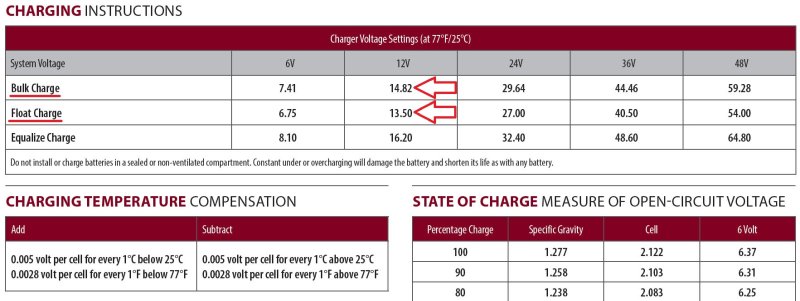Faster charging for AGMs. In practice what does this mean.
AGMs are touted as permitting faster charging then lead acid. In the real world, Bay Pelican, does this have any practical effect?
Bay Pelican has 12 Trojan 105 six volt batteries. Two chargers, one Magnum, one Victron, are used with the bank split in half, thus each charger charges six batteries for a total of 675AH. In the bulk charge stage each charger will output about 100 amps then quickly drop down. The 100 amp is within the limits for charging of a 675 AH lead acid bank.
If I switch to AGMs and use the AGM setting on both chargers will the bulk charging state run longer than with the lead acids. If not I have no faster charging.
Can anyone explain how this would work?
You're charging at approx 0.15C or just 15% of Ah capacity. This is light for your bank size. Also, if you are not maximizing your Trojan charging, by setting absorption to 14.8V (temp compensated), then you could be getting more into the batteries in a shorter time frame and treating them in a considerably more healthy fashion. Most boats I set foot on are grossly under charging flooded Trojans and also grossly under absorbing them time wise.
Sure the Coulombic efficiency of an AGM is better than flooded (AGM, GEL and Flooded are all
lead acid chemistry) so it converts more incoming energy at high states of charge, to stored energy but, unless you can maximize the charge rate to 25% to 40% + of Ah capacity, you're not really doing AGM's any favors nor maximizing the potential benefits.
Lifeline for example wants to see a minimum charge rate of 20% and Odyssey, the inventors of TPPL AGM's, want to see a minimum charge rate of 40% of Ah capacity for optimal cycle life. This is a 40A charge rate for a 100Ah battery or 270A charge rate on a 675 Ah bank.
There is also a rather wide quality spread among AGM's and how they handle PSOC use (partial state of charge). For info and comparisons between brands see the
May 2015 and
August 2015 issues of Practical Sailor. In this PSOC testing the Deka/East Penn AGM, Lifeline AGM, Northstar TPPL AGM, Odyssey TPPL AGM and Firefly Carbon Foam AGM were compared in a head to head 30 day PSOC test.
Not to be a spoiler but one AGM lost nearly 30% of its Ah capacity, in 30 PSOC cycles, and one battery lost no Ah capacity at all.. Not all AGM batteries are created equal.



